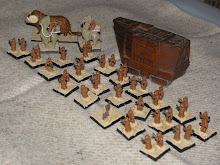Recently I had the opportunity to play a game of Volley and Bayonet with a co-worker who had expressed a interest in wargaming the period. They had also expressed a desire to play a French army. Fortunately I had one handy.
 |
| Some handy French. |
The next step was to find a scenario. After a quick search on the internet, we found this one for the
Battle of Craonne. Unfortunately, I don't have a Russian army, but I did have the bulk of a Prussian force, and some British oddments available for immediate use.
 |
| The gaming table. |
This was not to be the only liberty taken with this scenario. The Allied Order of Battle was to have some major omissions adding up to a reduction of four units of artillery, and one brigade of cavalry. We also decided that the game would end after eight turns with the notional arrival of the Allied Cavalry Corps of six brigades of cavalry.
 |
| French Artillery. Happy to outgun the Allies. |
These changes meant that the Allies would be outgunned and outhorsed, but they would have the advantage of just needed to hang on and block the French from seizing the main town in order to seize the day.
 |
| The Brave Allies. |
The Allied plan was simple, quickly seize the town on the left flank., while holding the French on the right flank, resulting in the center being the place where the French would be beaten.
 |
| The Old Guard watches as their cavalry streams back. |
Action began on the Allied right flank with the Allied cavalry bravely attacking the superior French cavalry, forcing them back to the protection of the French Old Guard. This was a good start to the plan.
While the Allies seemed to being getting thew best of the right flank, A French division managed to advance into the town.
 |
| Three brigades of difficult to dislodge. |
That division would prove problematic throughout the game. How problematic was not yet realised by me.
 |
| The center, before it got bad. |
The falling back of the French cavalry meant that the Allied cavalry could attack the French first line in the flank, and hopefully rout them.
 |
| A fuzzy look at the center. Two brigades of Allied cavalry are about the thunder down on the French from the Allied right. |
Only poor Allied dice rolling could save the French, coupled with some great rolls of their own.....
 |
| Fortunately, the Allies have a reserve. |
So as the Allied hopes in the center are dashed, and French elan wins the day, the battle for the town continued.
 |
| Many things in this picture are a work in progress, including clearing out the French! |
The battle was a meat grinder for both sides, with the French being slowly pushed back, but never completely so.
 |
| The lower half of the town is cleared. |
The rest of the battle unfolded quickly, so I didn't take any more pictures. As the Allied first line in the center collapsed I threw in my second line to try and hold it. At the same time I siphoned off troops from third line to try and finally win the struggle for the town. This resulted in disaster as the French Old guard, and the recently rallied French cavalry swept down my right and into the centre, leaving me with a strong position on the left, but not complete control.
My opponent generously stated it was a draw as the notional cavalry reinforcements would be able to stabilise my position and the game had reached the point of their arrival, and French losses had also been heavy! All in all, it was a very enjoyable game and has inspired me to start the refurbishment of more Napoleonic figures!


















